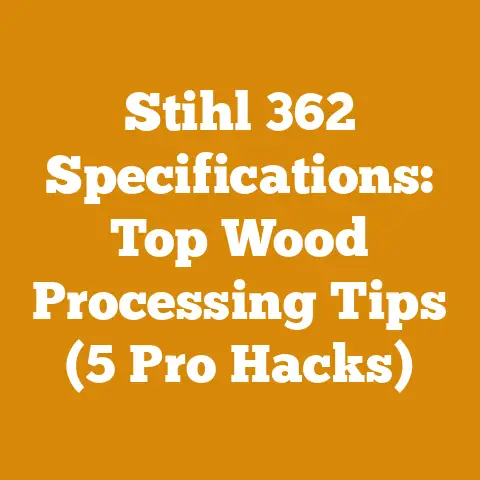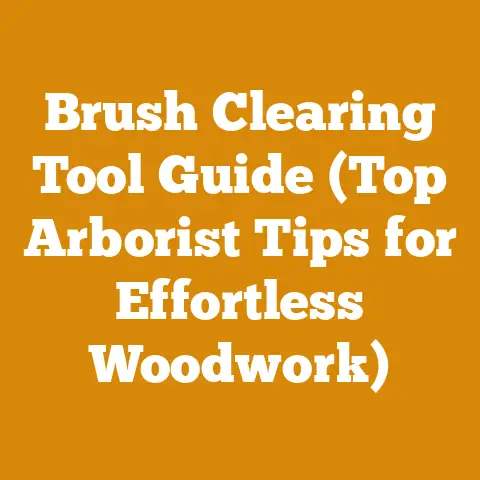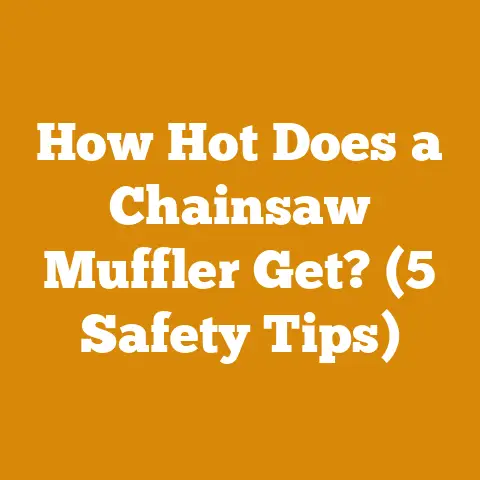Stihl Trimmer Attachment Compatibility (5 Pro Tips for Arborists)
Sometimes, the sharpest tool in the shed isn’t the one you expect. In the world of arboriculture, we often think of chainsaws as the undisputed kings. But the unsung heroes – the trimmers – can be just as vital, especially when paired with the right attachments. Navigating the compatibility of Stihl trimmer attachments can feel like deciphering an ancient code. That’s where my experience comes in. I’ve spent years in the thick of it, from felling towering oaks to delicately shaping hedges, and I’ve learned a thing or two about maximizing the versatility of these powerful tools.
This article is for anyone who wants to understand how to get the most out of their Stihl trimmer by using attachments. I’m going to share five pro tips that I’ve learned over the years that will help you choose the right attachments for your needs, ensure they’re compatible with your trimmer, and use them safely and effectively. Let’s dive in.
Stihl Trimmer Attachment Compatibility: 5 Pro Tips for Arborists
1. Decoding the Stihl Attachment System: Know Your Kombi
The first, and perhaps most crucial, step is understanding Stihl’s attachment system. The cornerstone of this system is the “KombiSystem,” which allows you to use a single powerhead with a variety of attachments. Think of it as the Swiss Army knife of the arborist world. It’s incredibly versatile, but only if you understand how the pieces fit together.
I remember one particularly frustrating afternoon early in my career. I’d just landed a contract to clear some overgrown brush from a local park, and I was eager to put my new Stihl KombiSystem to work. I had the powerhead, a brushcutter attachment, and a hedge trimmer attachment. Or so I thought. I quickly discovered that the hedge trimmer attachment was incompatible with my powerhead. The connection was wrong, and the whole thing was a useless pile of metal. That day, I learned a valuable lesson about the importance of understanding the compatibility of Stihl trimmer attachments.
Here’s the key takeaway: not all Stihl attachments are compatible with all Stihl powerheads.
- Know Your Powerhead: Stihl powerheads are classified by model number (e.g., KM 56 RC-E, KM 94 RC-E, KM 131 R). Each model has specific power output and connection types.
- Understand the Attachment Type: Attachments are designed for specific tasks, such as hedge trimming, edging, brushcutting, or cultivating. Each type has different power requirements and connection mechanisms.
- Check the Compatibility Chart: Stihl provides compatibility charts that clearly indicate which attachments are compatible with which powerheads. These charts are available on the Stihl website, in Stihl catalogs, and at authorized Stihl dealers.
Data Point: Stihl offers over a dozen different KombiSystem attachments, each designed for a specific task. The powerheads range from lightweight models suitable for homeowners to heavy-duty models designed for professional use.
Actionable Tip: Before purchasing any attachment, always consult the Stihl compatibility chart. This will save you time, money, and frustration.
The KombiSystem isn’t the only option. Some trimmers have fixed heads, which means you can’t change the attachment. These are typically less expensive but also less versatile. Other trimmers have a universal attachment system, which allows you to use attachments from other manufacturers. However, I’ve found that sticking with Stihl attachments is generally the best option, as they’re designed to work seamlessly with Stihl powerheads.
2. Power and Performance: Matching the Attachment to the Task
Once you’ve confirmed that an attachment is compatible with your powerhead, the next step is to consider whether it’s the right tool for the job. Power and performance are critical factors to consider when selecting a Stihl trimmer attachment. Using an underpowered attachment can lead to inefficient work and premature wear and tear on your equipment. Conversely, using an overpowered attachment can be dangerous and difficult to control.
For example, a lightweight edger attachment is perfectly suitable for trimming grass along sidewalks and driveways. However, it would be completely inadequate for clearing heavy brush or cutting through thick saplings. Similarly, a powerful brushcutter attachment is ideal for clearing dense vegetation, but it would be overkill for trimming hedges.
Data Point: Stihl brushcutter attachments range in cutting width from 8 inches to 20 inches. The larger the cutting width, the more power is required to operate the attachment effectively.
Real-World Example: I was once tasked with clearing a large area of overgrown blackberry bushes. I initially tried using a lightweight trimmer with a string trimmer head. The trimmer struggled to cut through the thick stalks, and the string broke constantly. After switching to a more powerful trimmer with a brushcutter attachment, the job became much easier and faster. The brushcutter attachment effortlessly sliced through the blackberry bushes, and I was able to clear the area in a fraction of the time.
Actionable Tip: Consider the type and density of the vegetation you’ll be cutting when selecting a Stihl trimmer attachment. For light trimming and edging, a lightweight attachment will suffice. For heavier brushcutting and clearing, a more powerful attachment is necessary.
Here’s a breakdown of some common Stihl trimmer attachments and their ideal uses:
- String Trimmer Head: Ideal for trimming grass and weeds around obstacles.
- Edger Attachment: Designed for creating clean edges along sidewalks and driveways.
- Brushcutter Attachment: Used for clearing heavy brush, weeds, and small trees.
- Hedge Trimmer Attachment: Perfect for shaping and trimming hedges and shrubs.
- Cultivator Attachment: Used for tilling soil and preparing garden beds.
- Pole Pruner Attachment: Designed for pruning branches high up in trees.
3. Attachment Maintenance: Keeping Your Tools Sharp and Ready
Like any tool, Stihl trimmer attachments require regular maintenance to ensure optimal performance and longevity. Neglecting maintenance can lead to decreased efficiency, increased wear and tear, and even safety hazards.
I’ve seen firsthand the consequences of neglecting tool maintenance. I once worked with a crew that was clearing a large area of overgrown vegetation. One of the workers was using a brushcutter attachment with a dull blade. He was struggling to cut through the thick stalks, and he was getting increasingly frustrated. In his frustration, he started applying more pressure to the blade, which caused it to bind and eventually shatter. The shattered blade sent shards of metal flying through the air, narrowly missing several workers. That incident served as a stark reminder of the importance of keeping your tools sharp and well-maintained.
Data Point: Regularly sharpening your brushcutter blade can increase cutting efficiency by up to 20%. A dull blade requires more power to operate, which can lead to increased fuel consumption and premature wear and tear on your trimmer.
Actionable Tip: Develop a regular maintenance schedule for your Stihl trimmer attachments. This should include cleaning, sharpening, and lubricating the attachment components.
Here are some specific maintenance tasks to perform on your Stihl trimmer attachments:
- Clean the Attachment: After each use, clean the attachment with a brush and mild detergent. Remove any debris, such as grass, weeds, or sap, that may be stuck to the attachment.
- Sharpen Blades: Sharpen the blades of brushcutter and hedge trimmer attachments regularly. Use a file or grinding wheel to restore the cutting edge.
- Lubricate Moving Parts: Lubricate the moving parts of the attachment with a light oil or grease. This will help to reduce friction and prevent wear and tear.
- Inspect for Damage: Regularly inspect the attachment for any signs of damage, such as cracks, bends, or loose fasteners. Replace any damaged parts immediately.
- Store Properly: When not in use, store the attachment in a dry, protected location. This will help to prevent rust and corrosion.
4. Safety First: Protecting Yourself and Others
Safety should always be your top priority when using Stihl trimmer attachments. These tools can be dangerous if not used properly. I’ve seen too many accidents over the years, and I want to make sure that you stay safe while using your trimmer.
I remember one incident where a homeowner was using a hedge trimmer attachment to trim a tall hedge. He was standing on a ladder, reaching high above his head, when he lost his balance and fell. He landed awkwardly on his arm, breaking it in several places. That accident could have been avoided if he had taken the proper safety precautions.
Data Point: According to the Consumer Product Safety Commission, over 20,000 people are injured each year while using trimmers and brushcutters. Many of these injuries are preventable with proper safety precautions.
Actionable Tip: Always wear appropriate personal protective equipment (PPE) when using Stihl trimmer attachments. This includes:
- Eye Protection: Wear safety glasses or a face shield to protect your eyes from flying debris.
- Hearing Protection: Wear earplugs or earmuffs to protect your hearing from the loud noise of the trimmer.
- Hand Protection: Wear gloves to protect your hands from cuts and abrasions.
- Leg Protection: Wear long pants or chaps to protect your legs from flying debris.
- Foot Protection: Wear sturdy boots with non-slip soles to protect your feet and ankles.
In addition to wearing PPE, here are some other safety precautions to follow:
- Read the Manual: Always read and understand the operator’s manual before using a Stihl trimmer attachment.
- Inspect the Area: Before starting work, inspect the area for any hazards, such as rocks, roots, or hidden objects.
- Maintain a Safe Distance: Keep a safe distance from other people and objects while operating the trimmer.
- Use Proper Technique: Use proper technique to avoid fatigue and injury.
- Take Breaks: Take frequent breaks to avoid fatigue and maintain concentration.
- Never Modify the Attachment: Never modify the attachment in any way.
- Never Use a Damaged Attachment: Never use an attachment that is damaged or malfunctioning.
5. Optimizing Performance: Techniques and Best Practices
Even with the right attachment and proper maintenance, you can still improve your efficiency and effectiveness by using the right techniques and best practices.
Data Point: Using the correct cutting technique can increase your cutting speed by up to 30%.
Real-World Example: When clearing brush with a brushcutter attachment, I’ve found that it’s most effective to use a sweeping motion, moving the blade from side to side. This allows you to cover a larger area and cut through the vegetation more efficiently. It’s also important to maintain a consistent cutting height to avoid scalping the ground.
Actionable Tip: Experiment with different techniques to find what works best for you.
Here are some specific techniques and best practices for using Stihl trimmer attachments:
- String Trimmer Head: Hold the trimmer at a comfortable angle and use a sweeping motion to trim the grass. Avoid scalping the ground.
- Edger Attachment: Guide the edger along the edge of the sidewalk or driveway, keeping the blade parallel to the surface.
- Brushcutter Attachment: Use a sweeping motion to clear brush and weeds. Maintain a consistent cutting height.
- Hedge Trimmer Attachment: Use a smooth, even motion to trim hedges and shrubs. Avoid cutting too deeply.
- Cultivator Attachment: Guide the cultivator through the soil, allowing the tines to break up the ground.
Unique Insight: One thing I’ve learned over the years is that the angle at which you hold the trimmer can make a big difference in its performance. For example, when trimming grass with a string trimmer head, holding the trimmer at a slight angle can help to prevent the string from breaking. Similarly, when clearing brush with a brushcutter attachment, angling the blade slightly can help to cut through thicker vegetation.
Final Thoughts:
Mastering Stihl trimmer attachment compatibility is about more than just matching parts. It’s about understanding the power of versatility, respecting the tools you wield, and prioritizing safety above all else. By following these five pro tips, you’ll not only extend the life of your equipment but also elevate your skills as an arborist. So, go ahead, explore the possibilities, and transform your Stihl trimmer into the ultimate landscaping companion.






